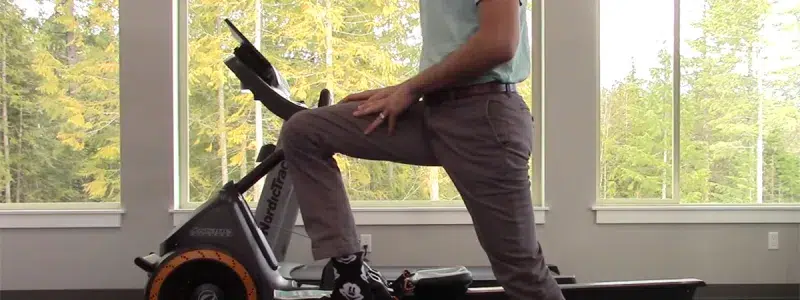Cycling can cause damage to the knee joint, leading to its loosening or wear and tear, which may cause a surgeon’s replacement of the knee.
Cycling on rough or uneven surfaces can speed up the wear and tear of knee replacements, resulting in shorter lifespans of the implants. Falls and fractures can happen from cycling because of knee joint instability.
Too much exercise too soon after surgery will put undue strain on the new knee joint. Even if you had knee surgery years ago, you can still wear out your joints.
In this blog post, we will explore whether cycling can wear out knee replacements, its harmful effects, why cyclists wear their knees out, and cycling knee wear-out replacement best practices.
Does Cycling Wear Out Knee Replacement: 6 Harsh Effects

Engaging in physical activities can feel daunting if you have undergone knee replacement surgery, especially if you love cycling.
While cycling is one of the best low-affected exercises for overall fitness, it may affect your knee replacements. You should know some effects of cycling on knee replacements:
Loose Implants
Cycling constantly pressures the knee joints, leading to implant loosening. Loose implants can cause instability and pain in the joint, leading to further complications.
Strain on Knee Joints
Cycling can put a lot of pressure on your knee joints, especially if you’re riding on uneven terrain or pushing yourself to the limit. As a result, it’s not uncommon to experience knee pain and discomfort when cycling.
Increased Wear and Tear
Cycling can be tough on joint implants because of the repetitive knee movements involved. The duration and speed of cycling can increase the wear and tear on these implants over time, potentially leading to damage.
Limited Range of Motion
Cycling primarily involves bending and straightening the knee joint, which may restrict your knee’s range of motion. This can be problematic if you must perform certain daily activities requiring more extensive joint movement.
Bone Loss
Cycling, like any other physical activity, can lead to bone loss if not done in moderation. This can be harmful in people with knee replacements, weakening the surrounding bone and making the joint more prone to instability and dislocation.
Compromised Healing
Cycling can interfere with the healing process of your knee replacement, especially if you have recently undergone surgery. The constant pressure on the implant delays healing and increases post-operative complications.
Cycling Wears Out Knee Replacements For 7 Reasons

Symptoms of knee replacement wearing out are common among cyclists. While cycling is an excellent activity that promotes joint health, engaging in it for prolonged periods can still lead to knee problems. Therefore, it’s essential to be aware of the signs of knee wear and seek appropriate treatment.
Incorrect Bike Setup
An improper bike setup can also cause knee wear in cyclists. If your bike is not fitted correctly, it might cause the knee joint to misalign, which stresses the kneecap. This can lead to conditions like PFPS, where you experience pain in the front of your knee.
Overuse of Knee Joints
Cycling, like any other exercise, can lead to knee wear if you overdo it. The repetitive motion of pedaling can stress the knee joints, causing damage to the knee cartilage and other tissues. This can lead to arthritis, patellar tendinitis, and patellofemoral pain syndrome (PFPS).
Inadequate Warm-Up
Before you hit the saddle, it’s essential that you warm up your muscles and joints to avoid injuries and knee wear. Failing to do so can cause stress on your knee joints and damage your knee cartilage.
Muscle Imbalances
Muscle imbalances are another reason cyclists wear their knees out. If your thigh muscles (quadriceps) are more robust than your hamstring muscles, it can exert undue pressure on the kneecap, leading to knee pain. Muscle imbalances can be corrected by engaging in exercises that target the underactive muscles.
Age
Age is another factor that increases the risk of knee wear in cyclists. As you age, the cartilage in your knee joint softens and wears down, leading to knee wear. Older cyclists may have weaker muscles and joints, making them more susceptible to knee problems.
Previous Knee Injuries
When you’ve had knee injuries before, you’re more likely to experience knee wear as a cyclist. Previous injuries can weaken the knee joint and make it more susceptible to further damage.
Training Errors
Training errors such as over-exertion, increasing intensity or duration too quickly, or inadequate rest and recovery can all contribute to knee wear in cyclists. To prevent this, accumulate your riding time and intensity and allow your body adequate time to rest and recover.
Knee Replacement Surgery and Getting Back on A Bike
For passionate cyclists, it’s encouraging to know that returning to cycling is often recommended by healthcare professionals as part of the recovery process after knee replacement surgery. Typically, you can anticipate resuming stationary cycling within two weeks of the operation, while road cycling may be feasible after 8 to 12 weeks.
Cycling After Total Knee Replacement
If you love cycling, the good news is that it’s one of the activities doctors recommend during your recovery. You can expect to return on a stationary bike two weeks after your knee surgery. However, cycling on the road may take up to 12 weeks post-operation.
Cycling After a Partial Knee Replacement
You had total knee replacement surgery and are planning to resume cycling, it is essential to listen to your doctors. Generally, static bikes are recommended after two weeks of surgery, and you can expect to return to road cycling between eight to twelve weeks after the surgery. It is crucial to be patient and not rush into physical activity before the recommended time for a successful recovery.
Return To Long-Distance Cycling After Knee Replacement

It is highly recommended that you gradually increase your distance after knee replacement surgery. By adhering to the recovery plan and focusing on enhancing the muscles around the knee, you should be able to resume long-distance cycling within a few months.
Mountain Biking After a Knee Replacement
Mountain biking can be resumed up to 12 weeks after your operation, just like road cycling. If you follow your physiotherapist’s advice and recover from your knee replacement faster, you may be able to get back on the horse sooner.
However, it is important to note that mountain biking is more dangerous off-road due to uneven terrain, so extra precautions should be taken.
9 Best Practices for Safe Cycling Knee Wear Out Replacement
If you have had knee replacement surgery and are an avid cyclist, you may wonder if cycling can wear out your artificial joint. There are some essential things to remember to ensure your cycling practices are safe and do not cause unnecessary wear and tear on your knees. Follow these tips when cycling wear-out knee replacements.
Consult With Your Doctor Before Cycling Post-Surgery
Before you cycle, it’s essential to consult with your doctor or physiotherapist to get their advice and clearance on whether cycling is safe for you. Depending on your knee replacement procedure and healing, your doctor may advise you to wait a certain amount or avoid certain types of cycling.
Focus On Low-Affected Activities
While cycling is a safe exercise for people with knee replacements, it’s essential to choose the right type of cycling for your current level of fitness and condition. Opt for low-affected activities, such as riding on flat terrain vs. hills, if you have any concerns about the stress it may place on your knee joint.
Get The Right Gear
Choosing cycling gear can be crucial in reducing the strain on your knees. Ensure your bike is properly fitted and adjusted so you are in a comfortable position that doesn’t put too much pressure on your knees. Consider investing in a more comprehensive or cushioned seat, pedals with straps, and shock-absorbing gloves to reduce impact further.
Break Up Your Rides
If you’re just getting back into cycling after knee replacement surgery, it’s essential to ease into it gradually. Avoid long rides at first and break up your cycling into shorter sessions during the day. As you progress, you can accumulate workout intensity and duration.
Listen To Your Body
It’s essential to listen and rest when needed. If you feel any pain or discomfort in your knees, take a break and give them time to rest. Overexerting yourself may cause unnecessary wear to your knee joint, which could lead to further complications down the line.
Get Medical Approval
Before you cycle, consult your doctor or physiotherapist to determine if engaging in physical activities like cycling is safe. They will advise you on the best course of action based on your circumstances.
Warm-Up

Before hopping on your bike, take some time to warm up your joints and stretch your muscles. Prevent injuries and make sure your body’s ready for the physical exertion of cycling.
Start Slowly
It’s essential not to push yourself too hard, especially in the early days of cycling after knee replacement surgery. Start slowly, and accumulate the intensity and duration of your cycling sessions as your strength and endurance improve.
Be Mindful of Pain and Swelling
If you experience pain, swelling, or knee discomfort after cycling, taking a break and seeking medical advice is essential. This can help prevent further damage to your knee joint and ensure you can continue cycling in the long run.
After Knee Replacement: 2 Critical Exercises
As for the critical exercises after knee replacement, two often recommended include.
Quadriceps Sets
Exercises that strengthen the muscles around the knee can help alleviate knee pain and prevent future injuries. One effective way to do this is by targeting the thigh muscles through squats, lunges, and leg presses. Incorporating these exercises into your workout routine can improve knee stability and lower body strength.
Straight Leg Raises
This exercise is a great way to target the quadriceps and hip flexors, which can help improve leg strength and stability. Exercises like this can build stronger and more resilient lower body muscles that will help you move with greater ease and agility.
Avoid These Knee Replacement Exercises
After a knee replacement, it’s crucial to avoid certain exercises that could put excessive stress on your new knee and potentially damage the implant. Here are some key exercises and activities to avoid:
- High-impact sports: Activities like soccer, basketball, running, and jumping should be avoided as they can cause undue stress on the joint.
- Contact sports: Sports that may lead to sudden twisting or jerking of the knee, such as football, rugby, skiing, hockey, and gymnastics, are not recommended.
- Heavy lifting: In the gym, focus on building strength in the muscles around the knee with less weight and more repetitions rather than trying to lift heavy weights1.
- Deep squats: While some squatting exercises may be beneficial, deep knee bends, and squats with added weight are generally not advised.
Physical Therapy For Knee Replacement
Physical therapy sessions following knee replacement surgery are designed to facilitate a smooth recovery and enhance the individual’s overall quality of life. These sessions typically commence shortly after the surgical procedure and continue for an extended period to ensure comprehensive rehabilitation. The primary objectives of physical therapy post-knee replacement include:
- Restoring Mobility and Function: Through targeted exercises and therapeutic interventions, physical therapists aim to improve joint mobility, enhance muscle strength, and facilitate the restoration of normal knee function.
- Managing Discomfort and Swelling: Postoperative discomfort and swelling are common concerns following knee replacement surgery. Physical therapists employ various techniques, such as cold therapy, compression, and elevation, to alleviate these issues and promote comfort during the recovery process.
- Customized Rehabilitation Plans: Each individual’s recovery journey is unique, and physical therapists create personalized exercise regimens tailored to specific needs and progress. These plans often include a range of motion exercises, gentle cycling, leg lifts, and other movements aimed at promoting muscle tone and joint flexibility.
Cycling Wears Out Knee Replacements Postoperatively Cear

After knee replacement surgery, recovery, and rehabilitation are crucial phases that require patience, care, and attention. Postoperative care and recovery time, as well as sleeping and using recumbent bikes, can significantly impact healing.
Sleeping After Knee Replacement
Achieving restful sleep after knee replacement surgery is essential for healing. Following the surgery, it’s common for individuals to feel uncomfortable and have difficulty sleeping.
Utilizing supportive pillows or cushions to elevate the legs and provide cushioning around the knee can aid in promoting better sleep quality. Additionally, adhering to the recommended sleep positions and maintaining a consistent sleep schedule can improve rest and overall recovery.
Recumbent Bike After Knee Replacement
The use of recumbent bikes as part of the rehabilitation process post-knee replacement surgery offers a low-impact, supportive means of engaging in physical activity. These specially designed stationary bikes provide a reclined seating position with back support, reducing knee strain while promoting gentle, rhythmic leg movement.
As individuals progress in their recovery, incorporating recumbent cycling can aid in improving circulation, enhancing lower body strength, and supporting overall cardiovascular fitness without exerting excessive pressure on the replaced knee joint.
Considering Knee Replacement X-rays
Throughout the postoperative phase, healthcare providers may advise periodic knee replacement X-rays to assess the positioning and integrity of the implanted joint. Imaging studies provide valuable information for evaluating the success of surgery, monitoring the healing process, and detecting complications.
By providing detailed insights into the knee joint condition, X-rays play a crucial role in ensuring the effectiveness and long-term stability of the knee replacement.
Conclusion
Cycling is an excellent, low-affected exercise that you can include in your post-knee replacement journey. You should remember that each person’s body is unique, and what may work for one person may not work for another.
Always listen to your body and consult your doctor before engaging in physical activity. Keep those wheels spinning, and enjoy the ride.
FAQs
What Expenses Does Insurance Typically Cover For A Total Knee Replacement?
Insurance coverage for a total knee replacement often includes charges related to hospitalization, surgical procedures, anesthesia, pre-operative evaluations, postoperative care, and in some cases, rehabilitation services. However, it’s essential to review the specifics of the insurance policy to ascertain the extent of coverage for various components of the procedure and related services.
How long after a knee replacement can I start cycling?
Most patients can begin cycling within a few weeks to a few months after knee replacement surgery, depending on their recovery progress. However, you must check with a physician or physical therapist to ensure you have the green light to resume exercise safely.


